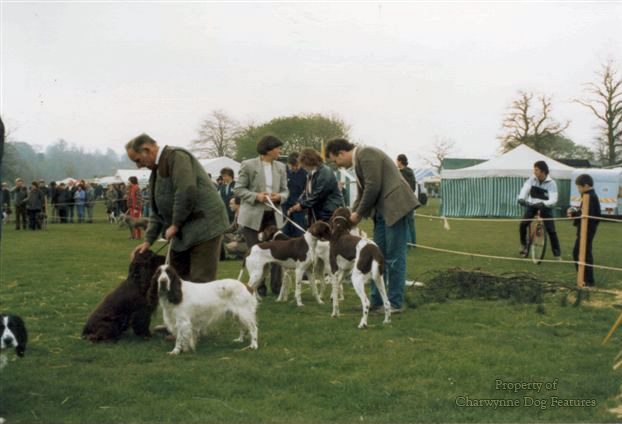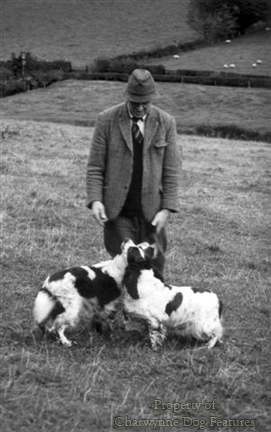788 FIELDING THE WORKING SPANIEL
FIELDING THE WORKING SPANIEL
by David Hancock
Loss of Minor Breeds
If you glanced at the annual registrations of spaniels with the Kennel Club you would be impressed by the sheer number being bred each year: some 38,000. But if you then take away the totals for two particular breeds, the English Springer and the Cocker, you would be left with less than a thousand registrations from all the other sporting spaniel breeds. Of four of the land spaniel breeds, the Welsh Springer can reach around 500 each year, but the remaining three give cause for serious concern. For the Clumber, with only around 200 registrations a year, the outlook is worrying. For the Sussex, with just over 50, and the Field, with around 75, the outlook is dire. These two old British gundog breeds deserve our support. In 1908 over 280 Field Spaniels were registered with the KC, against less than 50 English Springers; the Sussex Spaniel was a dying breed even then. Just after the Great War, the Field Spaniel was outcrossed to the English Springer Spaniel, led by Mr RR Kelland with his Black Prince and Mr G Mortimer-Smith’s renowned Wribbenhall strain. In due course, the Field Spaniel Society, formed in 1923, was able to organise field trials where Major Beaumont’s Strouds kennel became highly successful.
In 1945, there were only 4 Field Spaniel bitches left to breed from and they were all by the same dog. In that year too, there were only 6 purebred Sussex Spaniels left, all owned by the same breeder and all closely related. In 1964 the Clumber Spaniel Thornville Snowstorm was mated to the Sussex Spaniel Weiden Jhansi of Patmyn. In 1978 there was at least one Sussex Spaniel owner still breeding this line. If such a course of action has actually strengthened the breed’s gene pool and breed type has survived I see little to complain about in this sort of breeding diversion. Nowadays in the shooting field the English Springers and the Cockers rule the roost. But I see so much to admire in the handsome springer from Wales, the distinctive spaniel from Sussex and the fussless Fields.

The Field Spaniel
It is not always easy to recommend a breed of gundog to an individual, what with differences of terrain, temperament, quarry and handler-capability. But when the country being shot over calls for the resolute flushing of game, then give me one of the old-fashioned spaniel breeds, ideally a Field Spaniel of say Rhiwlas breeding. I once spent a day on a Welsh hillside with part-time gamekeeper Clive Rowlands watching his Rhiwlas Field Spaniels work the undergrowth like little tanks (and later going on to call on the admirable Jack Tallant, who developed this line). A combination of low-growing bramble and bracken or thick gorse is more than a match for a fast whippety field-trials’ dog, whose instinct may be to try to go over dense prickly undergrowth rather than get his head right down and bore his own trail. A sturdy Field Spaniel with a powerful low drive is the breed for such a task. In making a plea to the shooting fraternity to utilise this admirable breed more, my mind goes back to a story told by that great spaniel fancier CA Phillips. He was recalling an occasion in Ireland in the 1920s when the Kildare hounds were drawing the new gorse at Castletown and finding it most difficult to work, with no foxes prepared to bolt for them. Colonel Claude Cane, from his adjoining property, teased the Master and said his spaniels would shift them. Invited by the Master to attend next time, Colonel Cane did so with six spaniels, four of them being black Fields, all well-known show winners, one of them Champion Celbridge Chloe. With hounds and field gathered together some distance away, the spaniels were sent in. A good deal of ribald comment came from the hunting people, but, in only a few minutes, out came not just pheasants, rabbits and the odd hare, but no less than six foxes and a grateful hunting field set off in pursuit.
Renewed Need for Empathy
I treasure my memories of a few brief hours on the Powys Estate with gamekeeper Peter Spilsby and his Field Spaniels and, as I mention above, time spent with part-time gamekeeper the late Clive Rowlands on a nearby estate with his busy energy-packed Field Spaniels. They were like little tanks in the way they penetrated the dense local cover. But even more noticeable was their rapport with their owner, whom they could not see; dog and man working in complete harmony. I recall with pleasure too the first time I saw, in Germany, the all-rounders at work, the hunt-point-retrieve breeds in action. Wrongly described as utility gundogs, their skills are wide-ranging and demand much from a handler. Thankfully I know of no instance in which one has been shot by an intolerant owner but, if shooting becomes a new 'welfare' issue, some could well be. For over a thousand years these dogs have adapted to man's needs; I do hope we keep theirs in mind. Our training methods may now be more enlightened, I do hope our empathy is too. Our breeding methods need to be more enlightened too, benefiting from scientific advances.

The Field Spaniel may well be the truest model for all our modern English breeds of land spaniels. This breed is the sturdy active contemporary version of the old sporting spaniel. To avoid confusion between Field (the name of the breed) and field spaniels (spaniels used in the field) it might have been preferable to have named this breed ‘The English Land Spaniel’. The present title is rather a nondescript name for a breed that is anything but nondescript. Today’s lively, well-proportioned, fine looking breed certainly merits a suitably distinctive name. Field Spaniels have made enormous strides in physical conformation since the antics of their fanciers of the 1890-1900 period, the peak of the ‘bassetized era’, in which a needlessly low stature was favoured. Then, exhibitors could be seen at shows actually aiming to impress the breed judge with the sheer length of their entry, to claim on one occasion, that Rother Queen was half an inch longer in the back than Undeniable, as a point of merit in a working gundog! Sometimes the greatest threat to a breed’s well-being comes from its own fanciers.